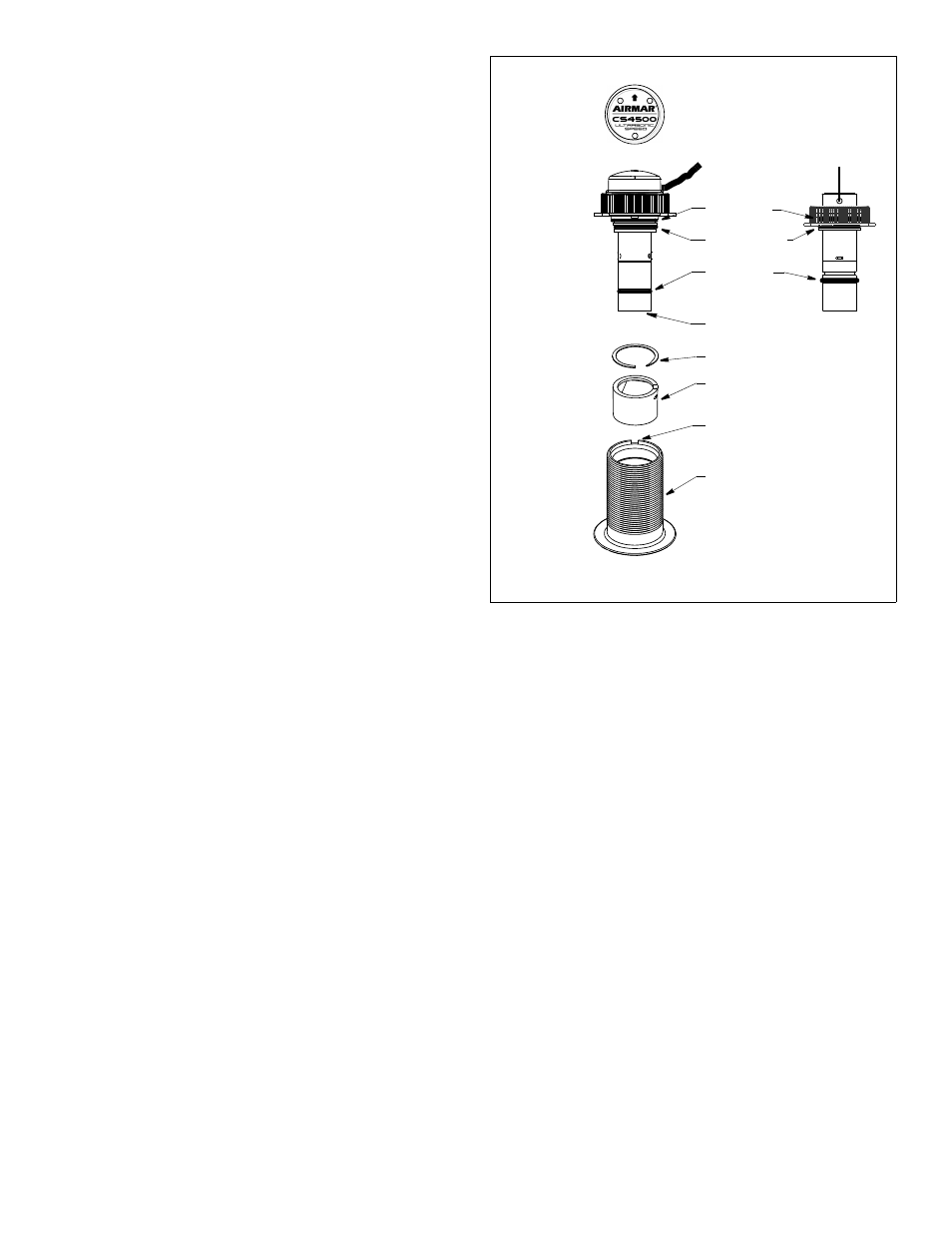Operation, maintenance & repair – Airmar CS4500-610—Ultrasonic Speed User Manual
Page 4

4
6. Sand and clean the area around the hole, inside and outside, to
ensure that the sealant will adhere properly to the hull. If there is
any petroleum residue inside the hull, remove it with either mild
household detergent or a weak solvent (alcohol) before sanding.
7. Proceed with “Bedding” and “Installing” on page 3.
Operation, Maintenance & Repair
How the Valve Works
The valve is not a watertight seal! The sensor incorporates a
self-closing valve which minimizes the flow of water into the
vessel when the ultrasonic insert is removed. The curved flap
valve is activated by both a spring and water pressure. Water
pushes the flap valve upward to block the opening, so there is no
gush of water into the boat. Always use the insert or the blanking
plug secured with the safety wire for a watertight seal.
Using the Blanking Plug
To protect the ultrasonic insert, use the blanking plug when:
• The boat will be kept in salt water for more than a week.
• The boat will be removed from the water.
• Aquatic growth build-up is suspected due to inaccurate
readings from the instrument.
1. Inspect the o-rings on the blanking plug (replace if necessary)
and lubricate them with the silicone lubricant supplied or
petroleum jelly (Vaseline
®
) (see Figure 5). The o-rings must be
intact and well lubricated to make a watertight seal.
2. Remove the ultrasonic insert from the housing by removing the
safety wire from the cap nut (see Figure 3).
3. Unscrew the cap nut to jack the insert out of the housing. This
will remove the cap nut and insert as a single unit.
4. Slide the blanking plug into the housing with the arrow pointing
forward toward the bow (see Figure 5). Seat it into place with a
twisting motion until the key fits into the notch. Screw the cap
nut in place and hand-tighten only. Do not over-tighten.
5. Reattach the safety wire to prevent the insert from backing out
in the unlikely event that the cap nut fails or is screwed on
incorrectly (see Figure 3).
Servicing the Ultrasonic Insert
CAUTION: The active face of the ultrasonic insert is fragile thus
easily damaged. Do not scratch, gouge, or sand it with coarse
sandpaper.
Aquatic growth will seriously affect the ultrasonic insert’s
performance. Clean the active face with a dull putty knife being
careful to avoid scratching the surface (see Figure 6). If fouling is
severe, lightly wet sand the surface with fine grade (#320) wet/dry
paper.
O-rings must be free of abrasions and cuts to ensure a watertight
seal. Install the large o-ring near the cap nut, the medium o-ring
below it, and the small o-ring near the active face (see Figure 5).
The three remaining o-rings are placed in similar positions on the
blanking plug.
Servicing the Valve Assembly
Should the valve fail, remove it for servicing. A replacement
O-ring and Valve Kit 33-450-01 is available.
1. On the blanking plug, inspect (replace if necessary) and
lubricate the o-rings with silicone lubricant or petroleum jelly
(Vaseline
®
).The o-rings must be intact and well lubricated to
make a watertight seal.
2. Remove the ultrasonic insert from the housing (see Figure 3).
3. Remove the snap ring from the valve assembly using a
screwdriver to pry the end of the ring free (see Figure 5).
4. Slide the valve assembly upward and out of the housing slowly.
NOTE: The flap valve retainer pin is a loose slip-fit and may
slide out when the assembly is removed.
5. Slide the blanking plug into the housing with the arrow on the
top pointing forward toward the bow. Seat it into place with a
twisting motion until the key fits into the notch. Screw the cap
nut in place and hand-tighten only. Do not over-tighten.
Reattach the safety wire (see Figure 3).
6. Clean, repair, or replace the valve assembly so the flap valve
moves freely and seats against the valve housing (see Figure 5).
7. Remove the blanking plug. Slide the valve assembly into the
housing with the flap valve pointing downward. Insert the snap
ring being certain that it locks into the groove in the housing
wall.
8. Slide the ultrasonic insert into the housing with the arrow on the
top pointing forward toward the bow. Screw the cap nut until
there is resistance. Seat the ultrasonic insert into place by
rotating it until the key clicks into the notch. Continue to screw
the cap nut into place hand-tightening only. Do not over-
tighten.
9. Reattach the safety wire to prevent the ultrasonic insert from
backing out in the unlikely event that the cap nut fails or is
screwed on incorrectly (see Figure 3).
Winterizing
After the boat has been hauled for winter storage, remove the
blanking plug to let the water drain away before reinserting it. This
will prevent any water from freezing around the blanking plug and
possibly cracking it.
snap ring
valve assembly with
flap valve, spring,
and retainer pin
housing
Figure 5. Servicing
top view of
notch
large o-ring
small o-ring
medium o-ring
active face
ultrasonic
insert
ultrasonic
insert
valve
assembly
housing
BOW
▲
blanking
plug
Copyright © 2002 - 2011 Airmar Technology Corp.
